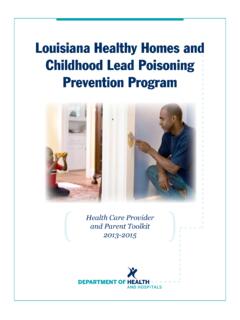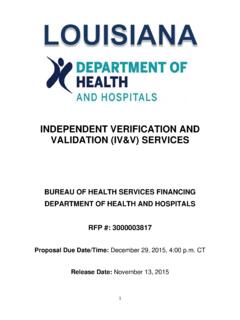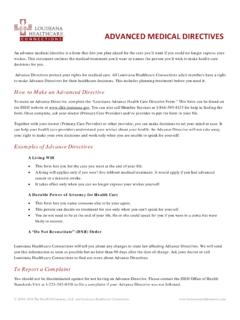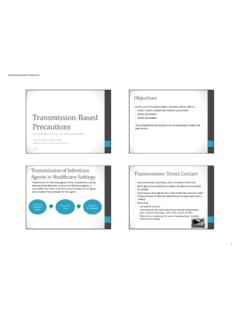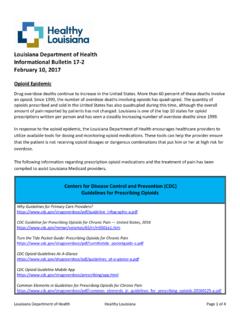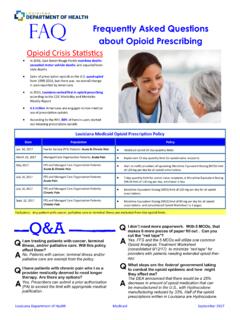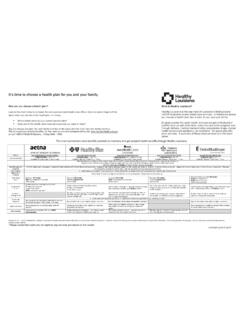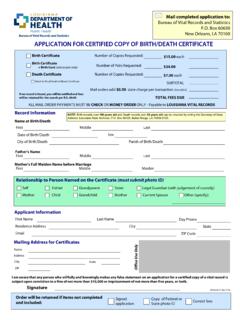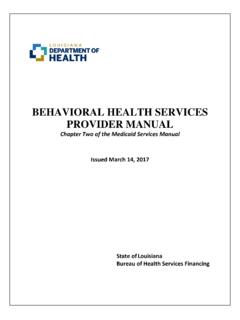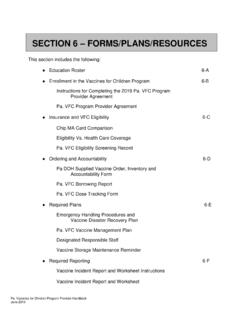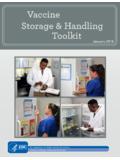Transcription of Vaccine Storage Handling - Department of Health
1 Table of Contents Vaccine Storage and Handling Guide National Center for Immunization and Respiratory DiseaseGeneral Information Vaccine Storage and Handling Best Practices 5 Selected Biologicals Diphtheria Toxoid-, Tetanus Toxoid- and acellular Pertussis-Containing Vaccines DTaP: DAPTACEL, Infanrix, Tripedia 11 DTaP-IPV: KINRIX 11 DTaP-HepB-IPV: Pediarix 11 DTaP-IPV/Hib: Pentacel 11 Haemophilus influenzae type b-Containing Vaccines Hib: ActHIB, Hiberix, PedvaxHIB 15 Hib-HepB: Comvax 15 DTaP-IPV/Hib: Pentacel 11 Hepatitis-Containing Vaccines HepA: Havrix, VAQTA 19 HepB: Engerix-B, Recombivax HB 19 HepA-HepB: Twinrix 19 DTaP-HepB-IPV: Pediarix 11 Hib-HepB: Comvax 15 Human Papillomavirus Vaccines HPV2: Cervarix 23 HPV4: Gardasil 23 Vaccine Storage and Handling Guide Page 2 Table of Contents Vaccine Storage and Handling Guide National Center for Immunization and Respiratory DiseaseInfluenza Vaccines LAIV: FluMist 27 TIV: Afluria, Fluarix, FluLaval, Fluvirin, Fluzone, Fluzone High-Dose, Fluzone Intradermal 29 Measles-, Mumps- and Rubella-Containing Vaccine MMR: M-M-RII 33 MMRV: ProQuad 69 Meningococcal Vaccines MCV4: Menactra, Menveo 37 MPSV4: Menomune 41 Pneumococcal Vaccines PCV13: Prevnar 13 45 PPSV23: Pneumovax 23 45 Poliovirus-Containing Vaccine IPV: IPOL 49 DTaP-HepB-IPV: Pediarix 11 DTaP-IPV: KINRIX 11 DTaP-IPV/Hib: Pentacel 11 Rotavirus Vaccines RV1: ROTARIX 53 RV5: RotaTeq 53 Tetanus Toxoid Vaccine TT.
2 Tetanus Toxoid 57 Vaccine Storage and Handling Guide Page 3 National Center for Immunization and Respiratory Disease Table of Contents Vaccine Storage and Handling Guide Tetanus Toxoid- and diphtheria toxoid-Containing Vaccines Td: DECAVAC 61 DT: Diphtheria and Tetanus Toxoid 61 Tetanus Toxoid-, diphtheria toxoid-, and acellular pertussis- Containing Vaccines Tdap: Adacel, Boostrix 65 Varicella-Containing Vaccines VAR: Varivax (chickenpox) 69 ZOS: Zostavax (herpes zoster/shingles) 69 MMRV: ProQuad 69 Resources CDC Resources 73 Other Resources 74 State Immunization Program Information 75 Manufacturer/Distributor Contact Information 76 Information contained in this document is based on the recommendations of the Advisory Committee on Immunization Practices (ACIP) and the manufacturer s product information.
3 A combination Vaccine is defined as a prod uct containing components that can be divided equally into independently available routine vaccines. A dash ( - ) between Vaccine products indicates that products are supplied in their final form by the manufacturer and do not require mixing or reconstitution by the user. A slash ( / ) indicates that the products must be mixed or reconstituted by the user. Vaccine Storage and Handling Guide Page 4 General Information Vaccine Storage and Handling Guide National Center for Immunization and Respiratory DiseaseVaccine Storage and Handling Best Practices Vaccines must be stored properly from the time they are manufactured until they are administered. Immunization providers are responsible for proper Storage and Handling from the time Vaccine arrives at the facility until the Vaccine is given.
4 Below is an outline of Vaccine Storage and Handling best practices. CDC s Storage and Handling Toolkit contains detailed information on Vaccine management. Immunization providers and staff are strongly encouraged to review the Storage and Handling Toolkit annually. Educate all staff, including temporary staff, as part of new staff orientation. In addition, Vaccines for Children (VFC) providers should follow VFC policy and work with their immunization program. Vaccine Management includes, but is not limited to, these three components. 1. The equipment used for Vaccine Storage and temperature monitoring is reliable and appropriate. 2. Staff is knowledgeable regarding proper Vaccine Storage and Handling . At least 2 staff members should be responsible for Vaccine management. 3. Written Storage and Handling plans are updated at least annually for: routine Storage and Handling of vaccines; and emergency Vaccine retrieval and Storage .
5 Routine Vaccine Storage and Handling Plan should include the following four elements. 1. Ordering and Accepting Vaccine Deliveries Store vaccines at the recommended temperatures IMMEDIATELY upon arrival. Store refrigerated vaccines between 35 F and 46 F (2 C and 8 C). Store frozen vaccines between -58 F and +5 F (-50 C and -15 C). Ensure vaccines are delivered when the facility is open. Vaccine shipments should be delivered when staff is available to unpack and store the Vaccine properly. Inform manufacturer/distributor when Vaccine shipments can be delivered. VFC providers should also notify the immunization program. Consider holidays, vacations, changes in hours of operation, and staff schedules when ordering vaccines. Educate all facility staff about Vaccine Storage . Vaccine shipments are often accepted by nonmedical staff.
6 They should be aware that Vaccine needs to be stored according to the manufacturer s guidelines immediately upon delivery. Vaccine Storage and Handling Guide Page 5 General Information Vaccine Storage and Handling Guide National Center for Immunization and Respiratory Disease Order vaccines to maintain an adequate amount to meet the needs of the facility s patients. The amount of Vaccine needed can vary throughout the year. Anticipate peak periods such as back-to-school appointments or influenza season and order accordingly. Order the vaccines and presentations that are appropriate for the ages and types of patients the facility serves. Influenza Vaccine , for example, is available from many manufacturers with differing indications.
7 Maintain a Vaccine inventory log including: 1. Vaccine name and number of doses received; 2. date Vaccine received; 3. condition of Vaccine on arrival; 4. Vaccine manufacturer and lot number; and 5. Vaccine expiration date. 2. Storing and Handling Vaccines Store vaccines in refrigerator and freezer units which can maintain the appropriate temperature range and are large enough to maintain the year s largest inventory without crowding. Stand alone units are preferred but household combination units with separate exterior doors and thermostats can be used. Dormitory-style refrigerators should not be used. A dormitory-style refrigerator is defined as a small combination freezer/refrigerator unit that is outfitted with one exterior door with an evaporator plate (cooling coil), which is usually located inside an icemaker compartment (freezer) within the refrigerator.
8 Store Vaccine in Storage units designated specifically for biologics. If biologic specimens must be stored in the same unit, these should be stored on a lower shelf to prevent contamination. Food and drinks should never be stored in the same unit with vaccines. Keep a calibrated thermometer with a Certificate of Traceability and Calibration* in the refrigerator and freezer. These thermometers should be recalibrated as recommended by the manufacturer. Post Do Not Unplug signs next electrical outlets and Do Not Stop Power signs near circuit breakers to maintain a consistent power source. Read and document refrigerator and freezer temperatures at least twice each workday- in the morning and before the end of the workday. Keep temperature logs for at least 3 years. *Certificate of Traceability and Calibration thermometer with calibration measurements traceable to a testing laboratory accredited by the International organization of Standardization, to the standards of the National Institute of Standards and Technology, or to another internationally recognized standards agency Vaccine Storage and Handling Guide Page 6 General Information Vaccine Storage and Handling Guide National Center for Immunization and Respiratory Disease Store Vaccine according to the manufacturer s instructions.
9 Aim to maintain Storage unit temperatures within the middle of the acceptable temperature range. This allows for the small temperature fluctuations that can occur in refrigerators and freezers without exposing vaccines to unacceptable temperatures. Ensure good air circulation around the Vaccine in the Storage unit. Proper air circulation is essential to maintaining the correct Storage temperatures. Bins, baskets, or some other type of uncovered containers with slotted sides or openings should be used to store the vaccines. There should be space between the containers to promote air flow. Store vaccines on the shelves away from the walls, and vents in the part of the unit best able to maintain the required temperature. Vaccines should never be stored in the door of the freezer or refrigerator.
10 The temperature here is not stable. Place frozen packs in the door of the freezer and water bottles in the door of the refrigerator to help the Storage unit maintain a constant temperature. Frozen packs or water bottle should be placed securely so they do not dislodge and prevent the door from closing. In addition, caution must be taken to avoid weighing down the door so much that the seal is compromised when the door is closed. Store unopened and opened vaccines in their original box with the lid in place until administration. Several vaccines must be protected from light. This practice also helps to ensure different vaccines are not stored together in the same bins or containers which can lead to Vaccine administration errors. And in the event of a power failure, studies have shown storing vaccines in the box helps to maintain the Vaccine at the appropriate temperature.
